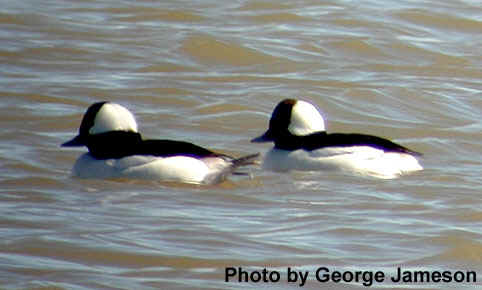(Bucephala
albeola)

(Currently studied by CWE researcher Matt Evans)
Click here for a list of publications by CWE researchers working at Riske Creek.
Population Delineation
The breeding population of Bufflehead extends across North America's boreal forest and aspen parkland with wintering grounds occurring along both the Pacific and Atlantic coasts. Little is known about exchange between these wintering populations during the breeding season but birds from Alberta are known to migrate to either coast (Gauthier 1993). Birds breeding west and east of Alberta are believed to be philopatric to the Pacific and Atlantic coasts, respectively. No genetic work has been done between the two wintering populations.
Distribution
Breeding Range
Migration Routes
Spring and Fall Staging Areas
Molting Areas
Winter Range
Abundance
Breeding Grounds
Staging Areas
Molting Areas
Wintering Grounds
Although no estimates exist, it is believed that most of the estimated 1.4 million Bufflehead winter along the Atlantic coast from the Maritime provinces south to Mexico. Birds breeding west of the Rocky Mountains winter along the Pacific coast from Alaska to Baja, California (Campbell et al. 1990). The most dense Pacific population is thought to be around southern Vancouver Island, British Columbia (Vermeer 1982, Gauthier 1993). Conant (1996) estimated 45,000 birds wintering off the coast of Alaska.
Population Trends
Although no reliable estimates exist, Bufflehead population numbers are generally considered stable or increasing (Gauthier 1993). Bufflehead numbers were severely reduced by over-hunting at the turn of the century (Erskine 1972) but protection under the Migratory Birds Convention between Canada and the United States has allowed steady increases over much of the bird's range. Audubon Christmas Bird Counts between 1927-1966 showed population increases, especially in the east (Erskine 1972). Breeding Waterfowl Surveys between 1955-1992 show Bufflehead increasing at a rate of 13,200 birds/year (p<0.001; Gauthier 1993). However, population declines have been reported in Alaska since 1979 and in the parklands of the Prairie provinces between 1980-1989 (Gauthier 1993).
Harvest
In general, harvesting rates have declined in Canada since the 1970's and increased only slightly in the United States (particularly in the east).
Management and Conservation Concerns
Concerns for the Bufflehead breeding population relate to the impacts of forest harvesting on the availability of suitable cavity trees for nest sites. Breeding populations are also threatened by agricultural expansion across the prairies. Wintering populations are also vulnerable to coastal petroleum transportation and to the threat of fuel spills.
Literature Cited
Bellrose, F.C.1980.Ducks, geese and swans of North America. (Rev. ed.). Stackpole Books, Harrisburg, PA.
Breault, A. Can. Wildl. Ser., Pacific and Yukon Region, Delta, B.C., Can.
Campbell, R.W., N.K. Dawe, D. McTaggart-Cowan, J.M. Cooper, J.W. Kaiser and M.C.E. McNall.1989.The birds of British Columbia. Vol. 1. Non Passerines. Royal British Columbia Museum, Can. Wildl. Serv. 514 pages. Stackpole Books, Harrisburg, PA.
Conant, B.1996.Population estimates for waterbirds wintering in southeast Alaska - 1996. Unpubl. Rep., U.S. Fish and Wildl. Serv., Juneau, Ak. 9 pages.
Erskine, A.J.1972.Buffleheads. Can. Wildl. Serv. Monogr. Ser. No.4.
Gauthier, G.1993.Bufflehead (Bucephala albeola). In The Birds of North America, No. 67 (A. Poole and F. Gill, Eds.). Philadelphia: The Academy of Natural Sciences; Washington, D.C.: The American Ornithologists' Union.
Levesque, H., B. Collins, and A. Legris.1993.Migratory birds killed in Canada during the 1991 hunting season. Can. Wildl. Serv., Progr. Note No. 204.
Martin, E.M., P.H. Geissler, and A.N. Novara.1990.Preliminary estimates of waterfowl harvest and hunter activity in the United States during the 1989 hunting season. U.S.F.W.S., Laurel, MD.
Martin, E.M., P.I. Padding, and P.H. Geissler. 1992. Preliminary estimates of waterfowl harvest and hunter activity in the United States during the 1991 hunting season. U.S.F.W.S., Laurel, MD.
Vermeer, K.1982.Food and distribution of three Bucephala species in British Columbia waters. Wildfowl 33:22-30.
Wentworth,
C.1998.Subsistence
waterfowl harvest survey Yukon-Kuskokwim Delta comprehensive report 1987-1997.
U.S.F.W.S., Migratory Bird Management, Anchorage, Alaska.
